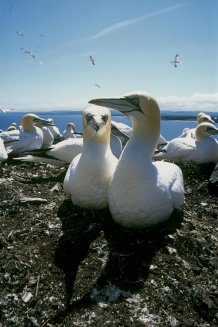
Gannets Morus bassinana, colony, Bass Rock by Andy Hay courtesy of rspb-images.com
Incredible ‘gannet cam’ captures birds’ eye view
Scientists from the University of Exeter and the RSPB have captured incredible footage of what it’s like to fly with the UK’s largest seabird.
Researchers working on the island nature reserve of RSPB Grassholm in Pembrokeshire, Wales, attached miniature cameras to some of the gannets that nest there with fascinating results.
The ‘gannet cam’ footage shows a bird flying high above the stunning Pembrokeshire coastline while ships pass below. The footage also shows the bird landing in the bustling colony, skimming low over the water and spectacularly plunging into the sea at incredible speed during a feeding dive.
The footage was taken by a team led by Dr Stephen Votier from the University of Exeter’s Environment and Sustainability Institute and Dr Mark Bolton from the RSPB, with support from Natural Resources Wales. Dr Votier has been carrying out research on the gannets on the tiny island of Grassholm off the Pembrokeshire coast for the last 8 years. The island, just 9ha in size is home to the fourth largest northern gannet colony in the world, with just under 40,000 breeding pairs.
Dr Votier pointed out that the unique footage (below) was obtained using a state of the art miniature camera developed by the RSPB Conservation Science team: “Seabirds spend most of their time at sea away from their nesting sites making them difficult to study. This camera really helps shed light on their behaviour away from the colony, for example it allows us to more accurately investigate their reliance on discards from trawlers and how they interact with other birds while far from land."
Dr Bolton, Principal Conservation Scientist at the RSPB who helped develop the devices said: “The lightweight camera works alongside a GPS unit that allows us to accurately track birds’ flight patterns and measure how long they are flying, feeding or resting. This information can answer both scientific and conservation questions and could contribute to the designation of marine conservation zones in Wales.”
This technique has already shed new light on ways that gannets make use of waste from fishing boats. It was found that male gannets tended to feed more at trawlers than females and this difference may have conservation implications when a ban on discarding is implemented under reforms to the EU Common Fisheries Policy.
Dr Votier believes that in the long-term the work will be hugely beneficial, “Gannets are long lived seabirds and there is still much to learn about their life away from the breeding colony. The application of technology to study the private lives of gannets has been influential to our research in the short-term, but the goal is to continue this work in the long-term to help provide a sustainable future for gannets and other marine life.”
Greg Morgan, Ramsey Island and Grassholm site manager commented: “This is a great example of partnership working between the RSPB and the University of Exeter. Dr Votier’s research has contributed greatly to our knowledge of our Grassholm gannets over the years and this is hopefully the first step in the next exciting chapter.
To learn more about the project visit the RSPB website.
The ESI is working with businesses and enterprises across all sectors of the economy in Cornwall, the Isles of Scilly and beyond to translate research and expertise into innovative business practices, products and services in order to respond to the challenges of environmental change. It has been funded by the European Regional Development Fund Convergence Programme (£22.9M) and the South West Regional Development Agency (£6.6M), with significant support from the Higher Education Funding Council for England.
Date: 12 November 2013
